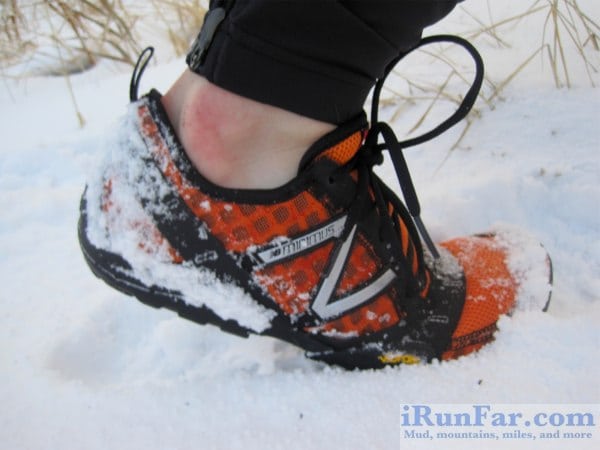Our Favorite Trail Running Shoes
Check out our Best Trail Running Shoes article to learn about our current favorite trail running shoes!
New Balance Minimus Trail Review
 The New Balance Minimus Trail is here… at least at iRunFar headquarters. Unlike most iRunFar reviews, we’re so excited to share this shoe with you that we reviewed this shoe as soon as we could
The New Balance Minimus Trail is here… at least at iRunFar headquarters. Unlike most iRunFar reviews, we’re so excited to share this shoe with you that we reviewed this shoe as soon as we could
Please feel free to ask away about the shoe and we’ll either share our personal experiences with the shoe or attempt to get you an answer. First, we highly recommend reading the comments, where we’ve answered many questions about the Minimus Trail.
Below, following an overview of the Minimus Trail, are my initial impressions, thoughts from my first run, and a look at the shoe’s components before some final words of caution. Without further delay, we present the New Balance Minimus Trail.
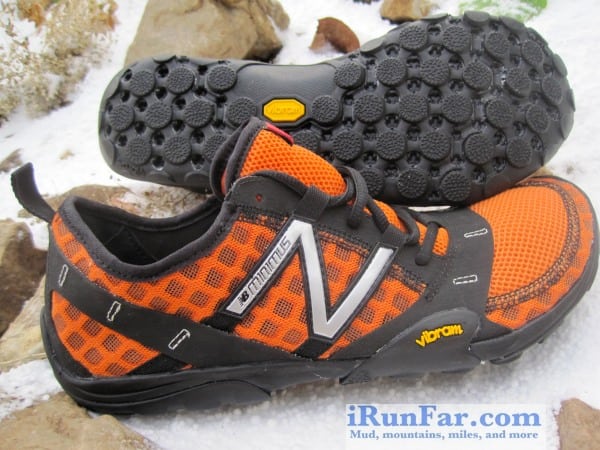
Minimus Overview
![]() In case you’re unfamiliar with New Balance’s forthcoming Minimus line, it’s a series of low-profile, minimalist shoes inspired by and designed with significant input from Anton Krupicka. While the Minimus line will include a Trail, Road, and Lifestyle shoe for both men and women, the Trail model is the one with the closest ties to Anton. New Balance and Anton have been keen to share the inspiration behind and development of the Minimus line. We previously shared some of this with you.
In case you’re unfamiliar with New Balance’s forthcoming Minimus line, it’s a series of low-profile, minimalist shoes inspired by and designed with significant input from Anton Krupicka. While the Minimus line will include a Trail, Road, and Lifestyle shoe for both men and women, the Trail model is the one with the closest ties to Anton. New Balance and Anton have been keen to share the inspiration behind and development of the Minimus line. We previously shared some of this with you.
First Impressions
First off, the NB Minimus Trail is visually stunning. I sit here entranced by the flashy orange, black, and silver. When I can focus on the details, I’m absorbed in the materials used in the shoe’s upper, many of which are striking in their uniqueness in a trail shoe. Flip the Minimus Trail over and it’s an outsole unlike any that I’ve seen before with nooks and crannies where I would expect lugs. I touch the shoe. I indulge in its plush interior. I want to put on this shoe rather than have it sit on my desk.
The scale doesn’t lie and the Minimus Trail in a US men’s 9 weighs in at 7.45 ounces (212 grams). Yes, there are lighter shoes out there. Even my slightly worn New Balance MT101s (iRF MT101 review) come in a gram or two lighter. Still, these shoes will not weigh down your feet. Your feet, however, will be down close to the ground. The Minimus Trail has a heel height of 9 mm with a toe height of 5 mm for a heel/toe drop of 4 mm.
Slipping my feet into the shoe, I quickly notice the natural constriction point – the ball of the foot. That’s where the outsole rises up both medially and laterally. Those protrusions onto the upper are connected by what appears to be a brushed rubber strap. The feeling of having your foot connected with your shoe at such a low point, just at the transition between metatarsals and toes, is quite different, though not uncomfortable.

The Minimus line’s “natural last” is also quickly apparent, particularly in the toe box. My toes have tons of space to wiggle around and ample room between toe’s end and shoe’s end. In testing the toe box, the shoe’s flexibility shows off a bit, too. In raising my toes, the front of the shoe, including the outsole, easily rise. What’s more, I can see any movement I make with my toes. Ahead of the brushed rubber strap, there is no structure to speak of in the Minimus Trail’s upper.
Before I proceed, we suppose you’ll want some details about when you can get a pair of New Balance Minimus Trails for yourself. Well, they’ll be available for $100 in March 2011.
First Run Impressions
To start, I’m not a full-on minimalist trail runner and definitely not a barefoot runner. There’s nothing wrong with either, I just haven’t gone in those directions. Since college, the lowest heel/toe drop that I’ve run in with any consistency is a 10mm drop as found in the MT101 and numerous other trail shoes. Therefore, it’s not surprising that I immediately felt tightness in my left calf, which has given me various issues over the past year and half. There was no pain, so I continued on.
What struck me most during this first run was how much the Minimus felt like a shoe. I mean that in a good way. My foot was protected from trail encounters with rocks, brush, downed tree limbs, and snow. I didn’t have to worry about where I placed every footfall. I could just run, which, I guess, is what I enjoy most.
Despite being a “shoe,” the Minimus Trail always left my body to do its own bidding. When climbing, my feet had to work. When I’d step on an obstacle, my foot would would drape over it. I was oft reminded that I have long neglected many lower leg muscles, which have atrophied even more over the past year while dealing with plantar fasciitis. These reminders weren’t a bad thing. They were a wake up call. Fortunately, I see the Minimus Trail (and MT101) as perfect tools to regain the trail strength I need.
As for performance, the shoe was quite comfortable. Although the run was short, I did not experience any hotspots or any hint of irritation during my sockless run. What’s more is that despite running on lightly snow-covered trails at 30F with a howling wind, my feet were never cold. (The one tip I would give likely snow runners is to err toward a larger size so you can wear running socks that cover the gap between your shoes and tights or pants.)
The Minimus Trail provided plenty of traction on loosely frozen dirt trails. It repeated the feat on snow without ever accumulating any snow in the outsole, as on the return leg of an out-and-back all my footprints were perfect imprints. Even the upper stayed largely snow free. Post run, the Minimus Trails had taken on a scant half ounce (13 grams) of water. I love that there’s precious little material to soak up water.
Components
Upper
The focus on minimalism is apparent in the NB Minimus Trail’s upper. There are structural elements, but not many. The only possible unnecessary components would be some slight branding on the tongue and outside of the shoe; however, even those elements have purpose as we’ll see.
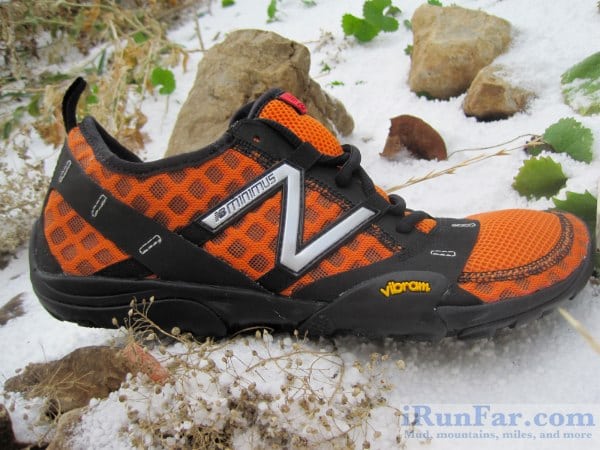
Two meshes comprise the majority of the upper.
The mesh at the front of the toe box, the sides, and the rear of the shoe is an extremely open mesh. This mesh is most often backed by a thin, much more finely woven fabric that both keeps out dust and debris as well as to serve as much of the shoe’s liner. This open mesh with backing, while flexible, is surprisingly inelastic and serves as structural fabric.
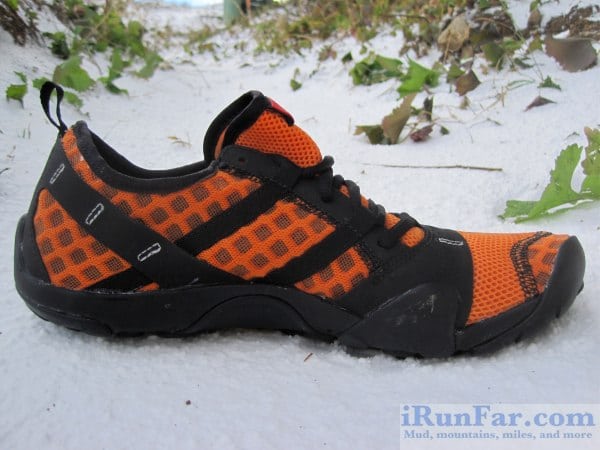
A moderately open mesh with a highly elastic backing material is found through much of the toe box and all of the tongue. This mesh allows for excellent mobility for your toes and the front of your ankle. The tongue is thin, but with enough cushioning to be comfortable. It’s also fully gusseted. There’s a small, rubberized New Balance Minimus logo at the top of the tongue. Given that the gusseted tongue can’t slip down much, that tiny piece may be unnecessary, but it is useful in making slight adjustments to the tongue and could be easily cut off if you care about milligrams. Together, the upper’s mesh make it feel light, airy, and good option on a hot day… though today’s 30F temperatures make that idle speculation.
Brushed rubber makes up many of the major structural components of the Minimus Trail. In the heel, a triangle of outsole rises up to an inch onto the upper. That triangle is flanked on each side by 1/2″ strips of the bushed rubber that merge into a 1 1/2″ vertical band. Two 3/4″-wide rubber strips extend diagonally from the top of the counter the rear of the midfoot. Together, these elements for a slight heel counter.
As noted in my initial impressions, there’s a rubber strip between the toes and metarasals. This strip helps connect your foot to the shoe and, I hypothesize, keeps your foot from slipping to the front of the shoe.
In the midfoot, a pair of 1 cm strips on both the inside and outside of the shoe provide support. A light plastic “N” overlay on the outside of the shoe provides a bit more structure. (This “N” may seem purely cosmetic, but I feel it is at worst insignicant and, much more likely, useful support that doesn’t greatly interfere with your foot’s mechanics.) Wrapping up the midfoot’s structure are rubber strips along both sets of eyelets running from the forefoot’s rubber strip to the ankle collar. With little substance in the midfoot, these eyelet bands help to bond the shoes to your feet.
I’ve got two final notes regarding the upper. First, the shoes laces are standard shoelaces rather than the MT100/101s sausage links. The laces are an appropriate length that do not require trimming, tucking, or triple knotting. Second, the ankle collar is gloriously low. I often have problems with ankle collars being too high. That’s not the case here. As a bonus, there’s a thin ribbon of silky fabric ringing the top of the ankle collar.
Upper’s Interior
Great design work is apparent throughout the Minimus Trail. However, once you look inside the shoe, you see the attention to craftsmanship. This craftsmanship is notable enough for me to mention the upper’s interior, a shoe aspect I rarely touch on here at iRunFar.
I suppose that given the sockless comfort of the MT101, I shouldn’t be all that surprised that shoe fits like a glove not just in fit, but also in on-body comfort. The vast majority of the upper’s interior is made up of silky smooth synthetic fabrics with unobtrusive stitching. In the heel, there’s what appears to be synthetic suede. This, too, is plush. The synthetic suede (if that’s what it is) also adds durability for where your heel slides in and provides a tad bit of additional structure in the heel. The footbed feels like a standard felt footbed. The only surprise is that it’s not removable.
Midsole
We can skip this one… there is no appreciable midsole. There’s the slightest of cushion underfoot, but no more than your standard insole.
Outsole
New Balance worked with Vibram to develop the Minimus Trail’s outsole. It’s a thing of beauty. It’s unique. In fact, it’s unique enough that it’s the design aspect of the Miminus line that New Balance kept most under wraps. We’ll skip trying to describe the lug pattern, as in this case an image is much more useful.
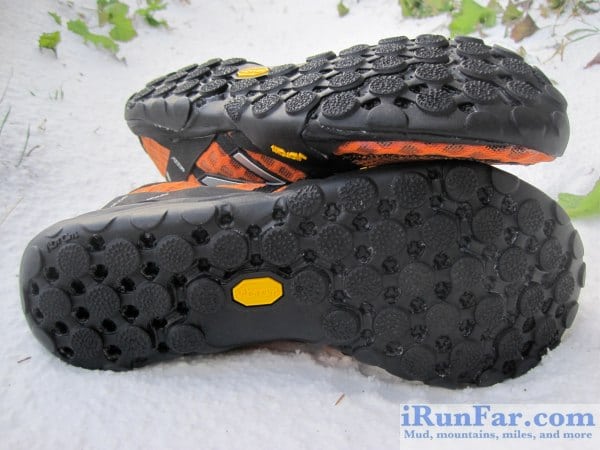
Aside from the lugs, the outsole is newsworthy in its use as a structural component in three places. As previously noted, the outsole is curved up near the ball of the foot and the heel to provide some structure. The third structure use of the outsole is as the entirety of the arch support. That’s right. The footbed of the Miminus Trail is completely flat. Instead, the outsole curves up in the instep to provide a modicum of arch support.
Words of Caution
I generally give a word of caution when reviewing minimally structured or low heel/toe drop shoes. This time I’m lucky as New Balance has been quite responsible in attaching the following to the Minimus:
Caution: This product increases the strain on the foot, calf, and Achilles tendon. Overuse of this product or use of activities outside of running and walking may increase the risk of sustaining injury.
This product should be introduced slowly into a running exercise routine. New Balance recommends limiting initial use to 10% of overall running workouts and very gradually increasing training time and distance.
If I remember correctly, distribution of the Minimus line will be tightly controlled when it is released in March 2011. I believe the only online outlet will be shopnewbalance.com and that there will be a significant educational aspect to the purchasing experience. I’m excited to see New Balance taking such care in releasing this product.
Call for Questions and Comments
Feel free to leave any comments you might have about the Minimus. If you’ve seen these in person or run in them, please share your take.
